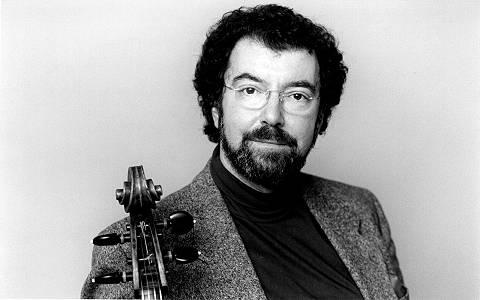
Fundamental spirit
The Pergamenschikow-Gililov recordings 1990-1994 -
appreciated by TESS CREBBIN'... fresh and invigorating ...'
|

|
<< Continued from Wednesday
1990 is the year that marked the first solo release on Orfeo by Pergamenschikow/Gililov, one year after the two friends had been introduced to the label by the flutist András Adorján. It became their international breakthrough as recording artists. On their first CD together as a duo, Pergamenschikow shows how far his musical genius reached beyond the highly acclaimed performances for which he had already become world-famous. The CD, with works by Brahms, Dvorák and Weber, features two of Pergamenschikow's own adaptations for cello. He adapted Dvorák's Sonatina in G Op 100 for violin and piano to cello and piano, and then did the same to Weber's Sonata in C No 6, this time collaborating with Gregor Piatigorsky.
Weber's work is the sixth sonata of a cycle called 'Six sonatas progressives pour le pianoforte avec violon oblige'. It was an assigned job that Weber completed in a mere eighteen days and the composition of which he called an 'ignoble job'. To the composer, this work was a burden, but to Pergamenschikow, all music was a means to feed the soul. Hence, with the distinct Pergamenschikow touch stamped all over it, Weber would probably be changing his mind about this sonata, the writing of which had put him into such a bad mood that he had complained: 'I can't put this together'.

Boris Pergamenschikow. Photo © Klaus Rudolph
|
Aside from an almost pedantic need for perfectionism, Pergamenschikow nurtured a deep love not just for sound but also for colors. So he takes a work that Weber barely ranked above good-for-nothing and turns it into a lion-hearted C major crusade of musical excellence. Weber's lukewarm approach to the original benefits from Pergamenschikow's adaptation, whose genuine love for music shines through every note. The Allegro
[listen -- C 210 901 A track 8, 4:07-5:18],
first movement in this three movement work, comes with a genuinely playful spirit as pianist and cellist seem to live out their love for music with only one purpose: to grant us, their listeners, and them, the interpreters, a lively blast of bliss.
Dvorák is a different matter: he composed the Sonatina in G for Violin and Piano Op 100, in 1893 in New York. He was under the influence of American folklore and Pergamenschikow, to whom the musical world of the United States remained somewhat of an enigma until he was bowled over by the jubilant audiences there, captures in his transposition some of the great mystery that the New World held for a Russian like himself. He cannot resist a certain amount of Weltschmerz in his adaptation that is melting into bliss under the stronghold of Gililov's happy-go-lucky piano. This piece sparkles with teasingly playful energy as the two performers engage in a dialogue of musical and personal harmony. Gililov's zealous piano has to deal repeatedly with an astute and diligent cello that digs beneath childish joy and seeks to bring out the essence of Dvorák's confrontation with a different culture. Brahms' Sonata No 1 in G Op 78, adapted by Paul Klengel for cello and piano, is just plain beautiful, carrying the listener off into a profound world of intense emotions, so penetrating that words would only put a blow on it, so it needs to be listened to without anything further being written on the subject.
Continue >>
Copyright © 10 October 2004
Tess Crebbin, Germany

|

